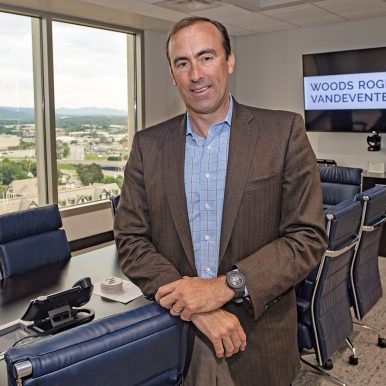Here to stay
The future of work is hybrid, say employers and HR execs

Working a hybrid schedule in her job as a health policy and payment specialist for the American Physical Therapy Association, Rachel Miller logs in remotely Mondays and Wednesdays from her Alexandria apartment. Photo by Will Schermerhorn

Working a hybrid schedule in her job as a health policy and payment specialist for the American Physical Therapy Association, Rachel Miller logs in remotely Mondays and Wednesdays from her Alexandria apartment. Photo by Will Schermerhorn
Here to stay
The future of work is hybrid, say employers and HR execs
Rachel Miller spent half of her undergraduate studies and then a portion of graduate school learning remotely behind a computer screen. Even the first job she took that aligned with her career goals — completing contact tracing during the COVID-19 pandemic while she worked toward her master’s degree in public health — was a remote job, performed while she was sheltering at home with her three roommates.
By the time she was set to graduate from her master’s degree program at the University of North Carolina in May 2022, Miller, who had taken some online courses even before the pandemic, was already accustomed to the autonomy and flexibility that remote work provides, but she also wanted a workplace where she could collaborate with and learn from her colleagues.
“Hybrid was definitely my ideal scenario,” says Miller, who has been working a hybrid schedule for a little more than a year in her job as a health policy and payment specialist for the Alexandria-based American Physical Therapy Association, which represents 100,000 physical therapy professionals and students nationwide.

She works 22 hours a week in the office on Tuesdays, Thursdays and Fridays. On Mondays and Wednesdays, Miller might log the rest of her hours — APTA has a 37.5-hour work week — from a coffee shop in the morning and then come home and prep dinner during her lunch hour. “It’s nice that we do have that flexibility,” she says.
It has been more than three years since the pandemic upended the workplace. While remote work may once have felt like a novel experiment, it is now a routine way of life for many white-collar workers. But since early 2022, the model has been shifting toward hybrid work.
Among workers whose jobs can be performed remotely, about 41% are working a hybrid schedule, up from 35% in January 2022, according to a Pew Research Center survey released in March. Meanwhile, the share of fully remote workers shrank from 43% to 35% during the same period.
Many offices reopened long ago, but with some employees already adjusted to a newfound work-life balance and employers confronted by a tight labor force, hybrid work has become less of a compromise and more of a minimum expectation. And experts and employers expect hybrid is here to stay.
“The norms have been dramatically altered because of remote work and the mass migration to remote work,” says Timothy Golden, a professor who studies remote work at New York’s Rensselaer Polytechnic Institute. “People — employers and employees alike — have been thinking differently about remote work and how work can best be carried out. Certainly, one of the big changes that has occurred as a result of many people working remotely is that now that is an acceptable way of working.”
From novel to normal
Remote and hybrid work models aren’t new. Decades ago, the federal government recognized telework as a powerful recruitment and retention tool and enacted legislation around it.
In 2019, only 24% of U.S. workers spent time working at home, according to the U.S. Bureau of Labor Statistics, while the share of employees who worked regularly from home in 2022 was 34%, down from 38% in 2021. According to Pew, only 7% of U.S. workers were fully remote before the pandemic.
A majority of U.S. executives surveyed in the most recent Survey of Business Uncertainty, conducted in July, said they expect their number of hybrid and remote workers to grow by 2.2% and 1% respectively during the next five years, according to the survey conducted by the Federal Reserve Bank of Atlanta, the University of Chicago and Stanford University.
But even before the pandemic expedited a mass experiment in remote work, some Virginia-based employers were already considering or piloting hybrid work arrangements.
Rachel Miller’s boss, APTA CEO Justin Moore, says workplace flexibility fits in with his association’s overall mission of wellness and helps with recruitment.
But prior to the pandemic, most employees worked on-site, and APTA’s few remote and flex work options were at the “margins of our strategy,” he says. The organization also wasn’t technologically equipped for remote work, but that changed in 2021 after APTA opened its new headquarters across from the new Potomac Yard Metro station. Planned before the pandemic, the headquarters includes technology to support remote work.
APTA implemented its 22-hour weekly in-office hybrid policy, which represents a 60/40 office/remote split, at the beginning of 2022. Employees commit to their in-office hours at the beginning of the year, and most choose to work on-site three days a week.
“It has created a little bit of spirit in the office that Thursdays is sort of a high-impact day of collaborative meetings, of energy in the building,” he says.
APTA also offers employees a week of “work from anywhere” time, a benefit that Moore says has been more popular with employees than any other perk.

Atlantic Union Bank added a similar perk for its hybrid workers, who total more than 1,000 employees out of a workforce of a little more than 1,800 people. (About 250 of Atlantic Union’s workers, or nearly 14%, are fully remote, mostly working in customer care, IT or risk and compliance roles.) The Richmond-based bank, which in July announced plans to acquire Danville-based American National Bank, now provides its employees 12 remote flex days a year.
“If they wanted to work a month from the beach in December or work remotely for a month at the end of the year, if they bank those things, they’ve got flexibility to do just that,” says the bank’s chief human resources officer, Clare Miller.
Atlantic Union added the flex days in June when it also instituted an updated hybrid work policy that generally calls for working in the office Tuesdays, Wednesdays and Thursdays, though some teams can modify that policy based on their needs.
‘An evolution’
Newer technologies that make it possible to work remotely have emerged alongside conversations about corporate social responsibility and spiking employee power.
“If you’re going to have a hybrid environment, you better make sure that people need to be there doing the things you could only do in person,” says Eli Jamison, an assistant professor at Virginia Tech University’s Pamplin College of Business.
But as workers log in from home offices, coffee shops or even the beach, remote work has begun meeting with increased C-suite resistance — and from some surprising quarters. Some of the nation’s biggest tech companies, including Amazon.com, Facebook parent company Meta, X (formerly Twitter) and Zoom — arguably the world’s largest enabler of remote work — have demanded workers return to the office in some fashion, citing problems with teambuilding, productivity or even fairness among those whose jobs demand them to show up in person.
Even Gov. Glenn Youngkin has weighed in; the Republican governor’s administration ordered state employees back to the office by July 5, 2022, which led to at least 300 resignations, according to a report from WRIC-TV, the ABC affiliate in Richmond. Most state employees are allowed one weekly telecommuting day, unless they receive special dispensation.
Amazon, which is building its East Coast HQ2 headquarters in Arlington County, where it plans to employ 25,000 people, mandated that corporate employees return to the office at least three days per week starting in May, leading to walkouts. More recently, a leaked message, obtained by Business Insider, showed the e-tailer would force ‘voluntary resignations’ among employees who refused to relocate around team hubs. Amazon has said it plans to have about 8,000 employees working hybrid schedules out of HQ2’s Metropolitan Park buildings by early October.
This has all been followed by news that the Biden administration will push to “aggressively execute” plans for more federal in-office work as early as September, Axios reported in early August. While the administration says it doesn’t plan to eliminate all remote work, the move comes on the heels of a July Government Accountability Office review that found that 17 out of 24 federal agencies were using 25% or less of their headquarters space in early 2023.
Some 1.5 million U.S. employees encountered new workplace attendance policies as of July, with another 1 million workers facing such mandates through the end of the year, according to research from Chicago-based real estate company JLL.
Falls Church-based Kastle Systems, which tracks entry data for 2,600 office buildings across 47 states, has estimated employee attendance hovering around an average 50% in major metropolitan markets this year. And JLL, which has noted that year-over-year worker attendance has increased by about 9% in 2023, has predicted that worker attendance could increase to more than 80% for the most popular midweek workdays by the end of this year.
While that may sound like good news to those in commercial real estate, return-to-office mandates also create opportunities for other companies to pick up talent, says Rensselaer’s Golden.
According to a job growth report issued in July from Scoop Technologies and People Data Labs, companies with workforces that are fully remote or structured hybrid (meaning the employer has set parameters around in-office time), added jobs at twice the pace of companies that are full time in-office from March to May.
Instituting hybrid policies has been “an evolution,” says Miller at Atlantic Union, which updated its policy this year to standardize three days in the office as opposed to suggesting two to three. It is a message to employees that in-office collaboration, opportunities for formal and informal development and participating in company culture remain important and are in the best interest of teams, Miller says. While some managers were nervous that the shift would cause employees to leave, Miller says those numbers have been “immaterial,” resulting in 1% or 2% turnover.
“We wanted … in-office vibrancy,” Miller says. “We wanted them to really see and feel the tangible benefits that can be gleaned when we have critical mass.”
Since June, teams have been eating lunches together, having one-on-one meetings and getting together to brainstorm in cross-functional groups, she says. Those interactions have been further helped by consolidating bank offices. “We recently moved staff in Richmond corporate offices to be more closely aligned by business unit, further deepening collaboration,” explains Miller.

Roanoke-based law firm Woods Rogers Vandeventer Black implemented its new hybrid work policy, effective Sept. 5. While the firm didn’t previously have a policy, other than to encourage employees to work in-office “more frequently than not,” it now “strongly encourages” employees work in the office three days a week but does not specify particular days, says firm President Dan Summerlin.
About 25% to a third of the firm’s 135 lawyers already work from the office full time, Summerlin says, with about 15% to 20% working mostly remote. That leaves about half of the firm’s lawyers working in hybrid mode, Summerlin says. “We understand that’s likely the way the world is going to be going forward,” he adds.
While WRVB won’t take attendance, attorneys who work remotely may have their offices turned into shared spaces, and the firm may consider different office reconfigurations as its leases are renewed, Summerlin says. The firm has seven or eight new associates starting, which was the impetus for the policy.
“We’re just going to be a little more smart about our space because having hallways with empty offices is not a great boost for morale for the staff or to the young lawyer coming in,” Summerlin says. “We sort of wanted to reiterate to everybody [that] we think we’re better and our firm culture gets passed on more easily if people are working together … in the office, as opposed to working from home.”
At APTA, a desire to be fair to workers represented by the association who are “back in the hospitals and back in the clinics treating patients” drove the decision to work a hybrid schedule, Moore says. “We wanted to be respectful of our providers that were seeing patients.”
Productivity problems?
One looming question in the debate over where employees work is how much work they’re getting done, and findings seem contradictory on this point.
Some studies have indicated hybrid and remote employees may work longer hours, in part because they are commuting less. For instance, a 2021 Microsoft study of 61,000 remote workers found their work hours increased 10%, though it also found a decrease in cross-company communication and collaboration between different business units. Additionally, a January University of Chicago study reported that teleworking saves workers an average 72 minutes of commuting per day, with about 40% of that time savings devoted to additional work.
A July report from Stanford University, however, found that fully remote employees are 10% to 20% less productive than their in-person peers. Hybrid work appeared to have no impact on productivity. The authors noted that hybrid work models have become popular among employers as a recruitment and retention tool and predict working from home will continue to grow as technologies improve.
In March, Nick Bloom, a Stanford professor and one of three authors of the university’s evolution of work study, tweeted that he expects that, in the long run, workforces will settle out with hybrid representing 50% of all jobs, fully in-person jobs 40% and fully remote jobs accounting for about 10%.
Rachel Miller spent the first 90 days of her job working in APTA’s office as part of the organization’s policy to aid with onboarding. Being in the office gives her the chance to informally engage with co-workers who may have expertise in areas she doesn’t. On days when she’s working remotely, Miller says, she may save questions for her supervisor.

“It’s much more fun for me to drop in the office and just ask a few questions than it is to explain something over [Microsoft] Teams or have a call on a day when we’re at home,” she says.
Moore, APTA’s CEO, estimates the association’s productivity is about 90% to 95% of what it had been when employees were on-site. And that’s a figure he’s willing to accept.
“We might get 95[%] productivity if we look at it on a week basis, but my guess is … because they have that choice and job satisfaction, that we gain [from] it in the long term,” he says.
Some companies, meanwhile, have found that offering fully remote work has given them a competitive edge in hiring without sacrificing productivity.
That remains the case for Atlantic Union, Miller says, though the bank is being more selective in its remote hiring as it has found competition for talent has diminished compared with 2021, which she says was the peak of the “war for talent.”
Before the pandemic, Richmond-based marketing firm Workshop Digital worked fully in-office out of a 10,000-square-foot space in the city’s Scott’s Addition neighborhood. With the help of a real estate firm, the company later found a tenant for the space after it sat empty for about a year. Now, about two-thirds of its 35 employees are local, and while Workshop Digital doesn’t have a hybrid policy, those who are in the area average one or two days in its co-working space weekly, says Brian Forrester, the company’s co-founder and CEO.
Workshop Digital leaders discussed adding remote workers before the pandemic, Forrester says, but worried it might stifle innovation and productivity. That hasn’t been the case. Now, the company employs remote workers from 10 states and is seeking a new, smaller office. Offering remote work has been a “major perk” in casting a wider net for talent, he adds.
“We’ve been able to hire sort of nationally the best talent available versus only those that would either relocate to Richmond, or, you know, those that were already local to Richmond.”
RELATED STORIES:
- Serving a repurpose: Vacant offices are revived as multifamily communities
- Talking telework: Executives and managers discuss how remote and hybrid models are changing work.

















